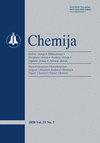气象因子对桥蒿植物化学成分的影响。
IF 0.4
4区 化学
Q4 CHEMISTRY, MULTIDISCIPLINARY
引用次数: 2
摘要
3立陶宛卫生科学大学药学院分析和毒理学化学系,立陶宛考纳斯苏基莱利街13号,50162。为了增加药用植物和其中积累的生物活性化合物的多样性,立陶宛非常重视引进蒿属植物。本研究的目的是测定立陶宛引进的桥蒿精油的定性和定量成分。调查对象——桥蒿草于2018年至2019年在Vytautas Magnus大学植物园科学系药用和芳香植物科学部门制备。2018-2020年,立陶宛健康科学大学药学院通过加氢蒸馏法分离精油,并通过气相色谱/质谱法分析其成分。所获得的结果显示,2018年,当HTC=1.32时,桥蒿精油中化合物的含量和多样性具有统计学意义(p>0.05)。经评估,2019年活动温度平均值与降水量之间存在很强的相关性(r=0.740)。当HTC=0.91时,化合物的含量降低了33.3%。其他主要化合物为1,8-桉叶素(46.86%)、1,4-桉叶醇(37.92%)和樟脑(29.41–33.02%)。本文章由计算机程序翻译,如有差异,请以英文原文为准。
The influence of meteorological factors on phytochemical composition of Artemisia pontica L.
3 Department of Analytical and Toxicological Chemistry, Faculty of Pharmacy, Lithuanian University of Health Science, 13 Sukilėlių Street, 50162 Kaunas, Lithuania In order to increase the diversity of medicinal plants and biologically active compounds accumulated in them, considerable attention is given to introduction of Artemisia L. genus plants in Lithuania. The aim of our study was to determinate the qualitative and quantitative composition of essential oils of Artemisia pontica L. introduced in Lithuania. The object of investigation – Artemisiae pontici herba were prepared in the Scientific Sector of Medicinal and Aromatic Plants, Scientific Department of Botanical Garden at Vytautas Magnus University in 2018–2019. Essential oils were separated by hydrodistillation method, their composition was analysed by gas chromatography/mass spectrometry methods in the Faculty of Pharmacy at Lithuanian University of Health Sciences in 2018–2020. The obtained results showed that a statistically significant (p > 0.05) higher amount and diversity of compounds from Artemisiae pontici herba essential oils were assessed in 2018 when HTC = 1.32. A strong correlation (r = 0.740) was assessed between the average of active temperatures and precipitation in 2019. The content of compounds was by 33.3% lower when HTC = 0.91. The other major compounds were 1,8-cineole (46.86%), 1,4-cineole (37.92%) and camphor (29.41–33.02%).
求助全文
通过发布文献求助,成功后即可免费获取论文全文。
去求助
来源期刊

Chemija
化学-化学综合
CiteScore
1.30
自引率
16.70%
发文量
14
审稿时长
>12 weeks
期刊介绍:
Chemija publishes original research articles and reviews from all branches of modern chemistry, including physical, inorganic, analytical, organic, polymer chemistry, electrochemistry, and multidisciplinary approaches.
 求助内容:
求助内容: 应助结果提醒方式:
应助结果提醒方式:


